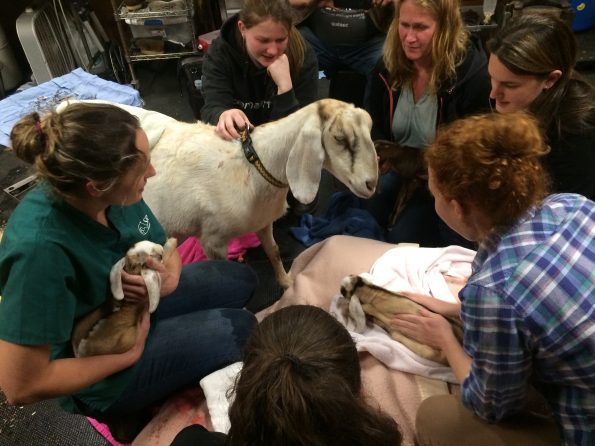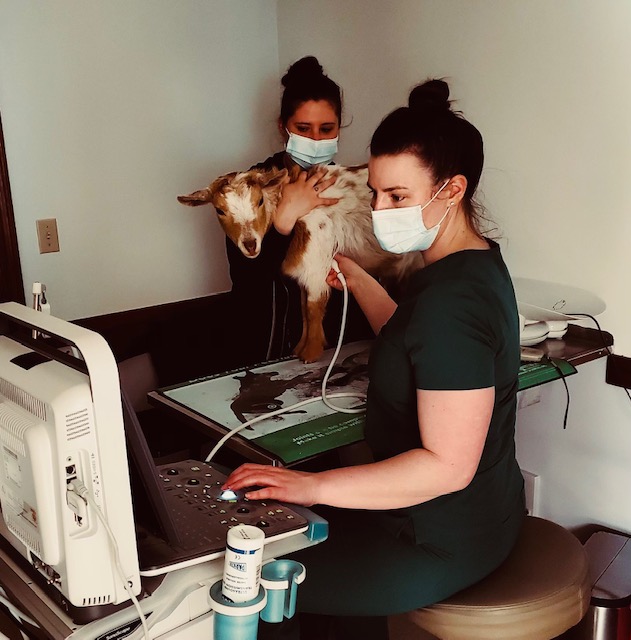Deworming and Parasite Control
Deworming Guidelines for Goats, Sheep, and Camelids
Resistance to deworming drugs (“anthelmintic resistance”) is common due to the prevalence of internal parasites in small ruminants and the limited number of deworming drugs that have been available in the last 50 years. Current recommendations for addressing anthelmintic resistance are to limit the use of dewormer to animals that have the highest worm burdens. Also, if an animal is being treated with dewormer, it may be better to treat with 2-3 drugs from different drug classes at the same time to improve the efficacy.
Every 2-3 weeks in spring and summer (less often is required during the colder months): Check the FAMACHA score of your animals. This involves examining the mucous membranes inside the lower eyelid of both eyes. You then compare the color to the FAMACHA card with scores 1-5. A score of 1 corresponds with red mucous membranes and a healthy animal. A score of 5 corresponds with white mucous membranes and a severely anemic animal. Anemia is a clinical sign of haemonchus contortus infestation, which is the most common intestinal parasite of small ruminants. Other worms may not cause anemia and therefore may not be detected as readily by FAMACHA scoring. Consider decreased body condition score, decreased growth rate, unhealthy hair coat, nasal discharge, bottle jaw, and diarrhea to be other signs an animal may benefit from deworming.
See this link for information on how to perform and interpret FAMACHA scoring: https://web.uri.edu/sheepngoat/files/FAMACHA-Scoring_Final2.pdf
Animals with scores of 4 (pinkish-white) or 5 (white) will be dewormed. Scores of 3 (pink) are left up to the discretion of the person examining the animal. Fecal egg counts (FEC) can provide additional information but are not recommended to be used as the primary criteria for deworming. FEC can be used for information on pasture contamination and for Fecal Egg Count Reduction Tests (FECRT) to determine anthelmintic resistance.
The preferred method of giving dewormers for small ruminants and camelids is via drenching (syringing down the mouth). This is best done with a dosing syringe made for drenching sheep and goats. Only formulations that are meant to be given orally should be drenched. Injectable dewormers have been shown to increase resistance and in some cases are more likely to result in an adverse reaction.
If there is concern that one dewormer is not effective enough to reduce the worm load (see fecal egg count reduction test below), we recommend giving multiple dewormers at the same treatment. Do not rotate dewormers over the same grazing season. When used in combination, each product should be given at the full dose, one after the other (do NOT mix them together in the same syringe). Withdrawal times would follow the label for the longer duration between the two products. There is some evidence that dewormer is more effective after a period of fasting. If feasible, give the dewormer in the morning before mealtime.
Young animals – especially from about 1 month to 5 months of age – are particularly susceptible to gastrointestinal parasitism. Pregnant and lactating animals – especially from late gestation to late lactation – are also at increased risk of high parasite burden. These animals are considered the highest risk if they are thin (low body condition) and have multiple fetuses/nursing young. Animals in these categories should be dewormed even if the FAMACHA score is >2.5.
New Herd Additions – When adding new animals to your herd they should be quarantined for a minimum of 2 weeks. During this time, they should be dewormed as directed, and ideally, have a FECRT performed to ensure treatments were effective before joining the herd.
Measuring the Effectiveness of Deworming – It is recommended that a farm (or any location that houses goats, sheep, or camelids) perform Fecal Egg Count Reduction Tests every 2-3 years to ensure the product(s) used for deworming are adequately effective. A fecal sample is collected before deworming, and then 10-14 days after deworming. As long as the original sample had > 250 epg, the second sample should show egg count reduction of at least 95% if the current deworming strategy is effective.
It’s important to note that many dewormers are not labeled for use in goats and the labeled sheep doses are ineffective in goats. Using dewormers at too low doses increases resistance. Dewormers should be used as directed by your veterinarian.
Management – Deworming alone will not fully protect animals from parasites and resistance. Management practices are equally if not more important. Pasture management, nutrition, stocking density and housing all have an influence on worm burden. Your veterinarian can help design protocols to better protect your herd.
Camelids are susceptible to infection with P. tenuis, a meningeal worm. We recommend deworming monthly with Ivermectin from May- Dec. Camelids should also have fecal egg counts performed in the spring and fall.
Sources:
American Consortium for Small Ruminant Parasite Control. Wormx.info
Targeted Selective Treatment (TST) by Susan Schoenian, MS. January 2020. https://60f7303d-ac52-4cac-b7fb-6050f500b0b6.filesusr.com/ugd/6ef604_9b34316f2c0148a7986d87e064b61ba4.pdf
Proper Use of Dewormers by Lisa Williamson, DVM, MS, DACVIM. March 2019. https://60f7303d-ac52-4cac-b7fb-6050f500b0b6.filesusr.com/ugd/6ef604_4c52af916e914093bdf24344ef522873.pdf
Using Fecal Egg Counts on Your Farm by Dahlia O’Brien, Ph.D. 2019. https://www.pubs.ext.vt.edu/content/dam/pubs_ext_vt_edu/APSC/apsc-166/APSC-166.pdf
American College of Veterinary Internal Medicine (ACVIM) Consensus Statement: Anthelmintic Resistance of Gastrointestinal Parasites in Small Ruminants. 2006. https://onlinelibrary.wiley.com/doi/pdf/10.1111/j.1939-1676.2006.tb02881.x






